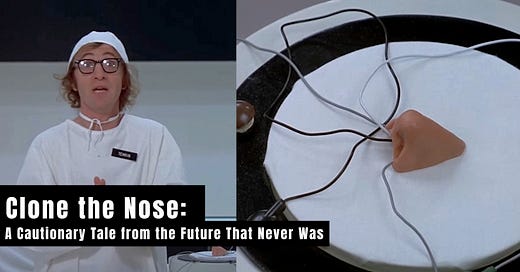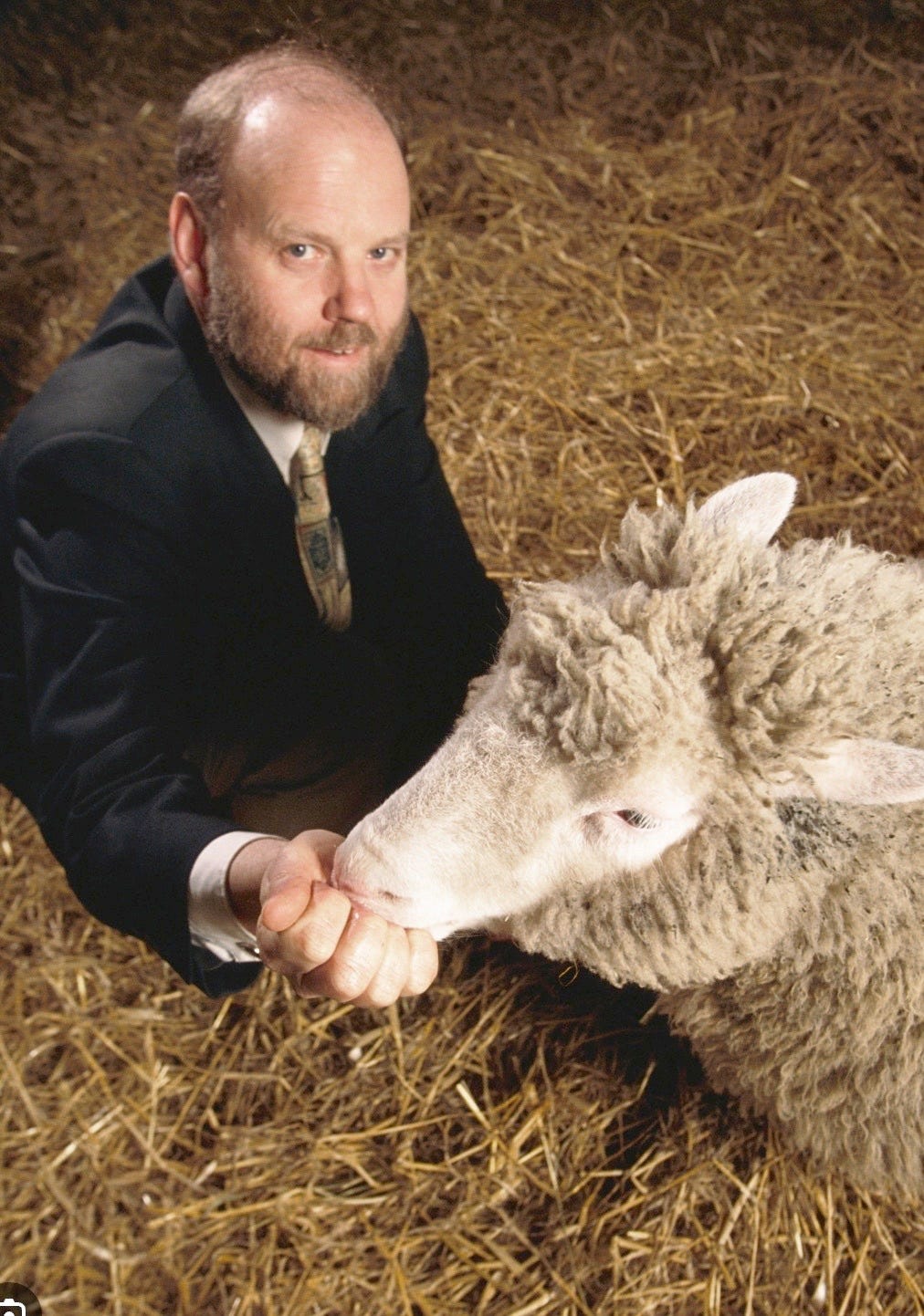Clone the Nose: A Cautionary Tale from the Future That Never Was
Back in the 1970s, Woody Allen gave us a scene that felt like science fiction wrapped in satire. In Sleeper, his character wakes up 200 years in the future and gets asked to “clone a nose.” The nose in question belongs to a long-dead dictator, and the scientists are breathlessly hoping to recreate the man from a single nasal tissue sample. It's absurd. It’s darkly funny. But more than anything, it captured a cultural moment when cloning felt like the next big thing.
We were going to clone pets. Clone ourselves. Maybe clone celebrities or children or the perfect Harvard-bound, blue-eyed über-toddler. The future was going to be full of copies. That was the dream—or the nightmare—depending on where you stood.
And then… it wasn’t.
Dolly, and the Dying of the Light
In 1996, the cloning future felt suddenly very real. Dolly the sheep, the first mammal cloned from an adult somatic cell, was born in Scotland and immediately became a global icon. She wasn’t just a sheep—she was proof. Proof that life could be copied. That identity could be duplicated. That biology could be rewritten.
But Dolly, like the cloning movement itself, didn’t live long.
She developed arthritis at a young age. Died at just six. And while her birth was hailed as a triumph, her death was a quiet funeral for the dreams of biological cloning.
Because here’s what happened next: the science didn’t scale. Cloning was expensive, inefficient, and riddled with failure. Dolly was the one success out of 277 attempts. Most clones were stillborn or suffered from severe health problems. Telomere shortening, cellular abnormalities, immune dysfunction—you name it.
Leon Kass, former chair of the U.S. President’s Council on Bioethics, expressed deep concerns about human cloning:
“A society that allows cloning has, whether it knows it or not, tacitly said yes to converting procreation into manufacture and to treating our children as pure projects of our will.” Leon Kass, “The Wisdom of Repugnance”
And so, quietly and without much fanfare, cloning became a backroom curiosity. No armies of perfect children. No duplicate selves. Sure, you can pay fifty grand today to clone your dog, but that’s not a technological revolution—that’s a luxury quirk for Barbra Streisand.
Which brings us to now.
AI: The New Clone Frontier
While the biological cloning movement was folding in on itself, another form of cloning was quietly gathering speed—digital cloning.
We call it AI. Sometimes, if we’re feeling grandiose (and let’s be honest, we usually are), we call it AGI: Artificial General Intelligence. But let’s not get too technical. What matters is this: AI isn’t about copying flesh and blood. It’s about copying mind. Thought. Speech. Personality. Memory. Self.
And unlike Dolly’s awkward stumble into existence, AI has arrived with velocity. Chatbots can mimic your writing. Voice models can clone your speech. Deepfake engines can reproduce your face, emotions, even reactions. Startups now promise "digital immortality" by training models on your data, your voice, your life.
A recent academic paper titled “Digital Doppelgangers: Ethical and Societal Implications of Pre-Mortem AI Clones” discusses the ethical challenges of creating AI replicas of living individuals:
“The rapid advancement of generative AI has enabled the creation of pre-mortem digital twins... However, their development raises critical ethical, legal, and societal concerns.” Vijayalaxmi Methuku & Praveen Kumar Myakala
It’s not science fiction. It’s subscription software.
And here’s the kicker: AI isn’t stumbling like cloning did. It’s running.
Will AI Hit the Same Wall?
Maybe. There’s a case to be made that we’re racing toward the same sort of collapse that doomed cloning. The warning signs are there.
The tech is overhyped. AI still hallucinates facts, invents sources, and fakes confidence. It doesn’t reason, it predicts. It’s a very convincing parrot, not a conscious thinker.
Ethically, we’re on a cliff’s edge. Who owns a digital clone? If you upload your personality into a bot, is it still you? Can someone else license it? Shut it off? Use it to sell cereal or manipulate voters?
And just like with cloning, there’s a creeping sense of unease. That by trying to replicate ourselves, we might be losing something essential. Authenticity. Humanity. Privacy. Control.
So yes, AI could hit a wall. A scientific one. An ethical one. A regulatory one.
But here’s the difference.
The Point of No Return
Cloning never became ubiquitous. AI already is.
You can still clone your dog—but it’ll cost you, and it probably won’t behave the way you remember. Meanwhile, you can already build a digital version of yourself that can write emails, schedule meetings, compose love notes, and maybe even outthink you in a tight spot.
We’re already seeing the birth of AI clones of ourselves, whether we asked for them or not. And unlike Dolly, they don’t need a lab. They live in the cloud.
What cloning failed to do with cells, AI is doing with data—replicating identity, memory, personality, and skill. And while we’re still arguing about whether AGI is around the corner or overhyped science fiction, what’s undeniably here is the digital doppelgänger.
It doesn’t have to breathe. It doesn’t have to age. It just needs enough of you to simulate presence. So maybe cloning didn’t fail after all. Maybe it just mutated—out of the petri dish, and into the neural net.
And if we’re not careful, we may soon find ourselves living in a world where the scariest part of cloning isn’t the nose in a jar, it’s the version of ourselves we no longer control.
But here’s the fundamental difference — the reason this story won’t end the way cloning did. Medical cloning was always tethered to a deep-rooted ethical framework. The Hippocratic oath. Institutional review boards. Generations of professional norms built around minimizing harm, protecting life, and respecting the human body. Biologists didn’t just stop cloning because it was hard — they stopped because it felt wrong. But technologists building AI? They’re not surgeons. They’re not operating under a centuries-old code of ethics. They’re operating under market pressure. Under investor expectations. Under the momentum of exponential scale. And while there are philosophers, ethicists, and regulators waving flags from the sidelines, the billions of dollars at stake make serious restraint almost unimaginable. Cloning was bound by “do no harm.” AGI is bound by “ship fast and monetize.” And that’s why this time, the clone won’t be stopped.
Steven Rosenbaum is an inventor, entrepreneur, filmmaker, and the author of the upcoming book The Future of Truth (BenBella Books/Simon & Schuster, Spring 2026)
Extra credit: “We’re here to see the nose, I heard it was running….”
.





